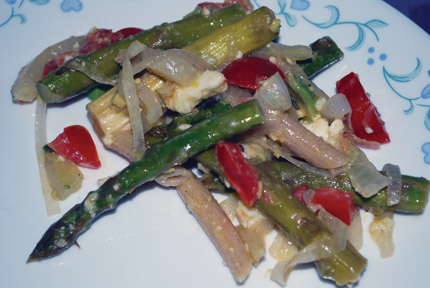Aquarium cooking demo promotes Seafood Watch
The Monterey Bay Aquarium hosted Otter Days, Sept. 25 and 26, a
day of events focused around the local marine mammals that look
awfully cuddly and cute. Chef David Anderson, of the Portola Cafe
and Restaurant, the onsite eatery at the Monterey Bay Aquarium,
conducted a cooking demonstration both days.
Aquarium cooking demo promotes Seafood Watch
The Monterey Bay Aquarium hosted Otter Days, Sept. 25 and 26, a day of events focused around the local marine mammals that look awfully cuddly and cute. Chef David Anderson, of the Portola Cafe and Restaurant, the onsite eatery at the Monterey Bay Aquarium, conducted a cooking demonstration both days.
The Monterey Bay Aquarium, for quite a while now, has put out a Seafood Watch card that recommends what types of fish or shellfish to eat. The card lists best choices, good alternatives and items to avoid, based on which ones are fished in the most environmentally-friendly ways. Since I don’t actually eat seafood myself, I’ve never paid much attention to the list but I’ve handed the card out to avid fans of the food so that they can make choices that promote healthy oceans.
The cooking demonstration served two purposes. It incorporated foods that sea otters enjoy eating – the mammals dine on shellfish that equates to as much as 25 percent of their own body weight in the wild per day, which according to one aquarium docent is equivalent to a human eating 400 sandwiches in one day. The second purpose was to highlight foods that are best choices on the Seafood Watch.
Anderson, with the help of another aquarium staff member, went through his recipe for a crab gallette – which is almost like a crab cake, but without the bread crumbs. While Anderson talked, the docent piped in with facts about the history of Seafood Watch, otters and the aquarium. Anderson’s recipe seemed simple enough and it included three items on the best choices list for Seafood Watch – including wild Dungeness crab, scallops from any source, and wild Pacific halibut.
Anderson went over a couple cooking methods, including the oven recipe below. But for the demonstration, he used a stove-top method. He heated a small pan, sprayed it with cooking spray and then filled a cooking ring with some of the mixture. He turned it partway through the process to allow it to cook all the way through. From the second row on the Tide Pool deck of the aquarium, the guests could smell the gallette cooking. As he finished up, other restaurant staff brought out samples. I didn’t try it, but those around me seemed to like it quite a bit.
At the Portola Cafe, the item is mostly served as an appetizer. But for anyone wanting to make more of a meal out of it, they could be served with the asparagus-fennel pasta salad below. The lemon juice and Dijon mustard flavor in the vinaigrette would pair fine with the fish dish.
For more on Seafood Watch, visit www.montereybayaquarium.org.
Dungeness crab gallette
Recipe courtesy of David Anderson – Portola Cafe and Restaurant, Monterey Bay Aquarium
1 bunch chives, minced
1 lb. Dungeness crab, drained
½ lb. scallops
½ lb. Pacific halibut, diced
2 eggs
1 pint cream
1/8 c. Dijon mustard
1/16 c. Tabasco sauce
1/8 c. Worcestershire sauce
Put scallops and halibut in a very cold bowl of a food processor. Process on high speed for one minute. Add eggs and process on high speed until the mixture is smooth and shiny (approximately 2 minutes.)
Keep scallop mixture in a bowl and put into freezer to rechill. Return bowl to processor and slowly add heavy cream while machine is running. Scrape sides of the bowl. Process one more time to make sure the cream is incorporated into a smooth mousse.
Add mustard, Tabasco sauce and Worcestershire sauce to the mousse, then fold into the crabmeat and chives.
Place the mousse into a silicon muffin tin.
Cook in a 350 degree oven for 20 minutes, or until internal temperature reaches 150 degrees.
Unmold and serve.
Asparagus-fennel pasta salad
Recipe courtesy of Taste of Home
1 lb. fresh asparagus, trimmed and cut into ¾-inch pieces
2 medium onions, halved and thinly sliced
1 small fennel bulb, sliced
2 tbsp. olive oil
8 oz. penne pasta
4 medium tomatoes, seeded and diced
12 pitted Greek olives, sliced
1 c. minced fresh parsley
Vinaigrette:
¼ c. olive oil
¼ c. lemon juice
2 garlic cloves
½ tsp. Dijon mustard
½ tsp. salt
¼ tsp. pepper
1 c. crumbled feta cheese
Place asparagus, onion and fennel in a 15-in. x 10 in. baking pan. Drizzle with oil; toss to coat. Bake at 400 degrees for 20 to 25 minutes, or until lightly browned and crisp-tender, stirring occasionally.
Meanwhile, cook the pasta according to package directions. Drain and place in larger serving bowl. Add tomatoes, olives and parsley and roasted vegetables.
In a small bowl, whisk the oil, lemon juice, garlic, mustard, salt and pepper until blended. Drizzle over salad and toss to coat. Sprinkle with feta cheese.
Yield: 14 servings.
3/4 cup equals 167 calories, 8 g fat (2 g saturated fat), 4 mg cholesterol, 278 mg sodium, 19 g carbohydrate, 3 g fiber, 5 g protein.










